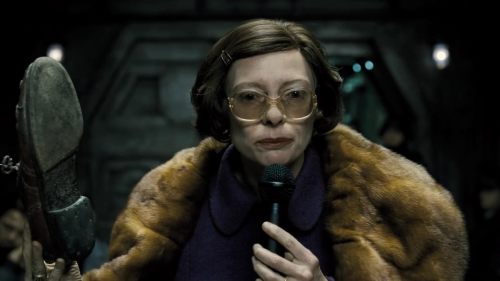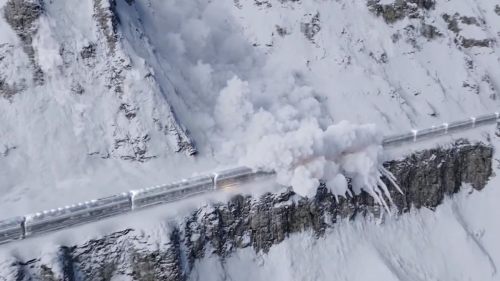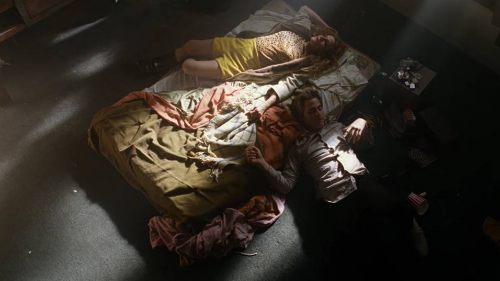NYCC ’19: SNOWPIERCER Is More Timely Than Ever In TNT’s Series
When the long-in-development Snowpiercer series debuts on TNT next spring, it will have been seven years since the premiere of Bong Joon-ho’s original movie. Coincidentally, the show takes place seven years after the big freeze that has turned the world into an uninhabitable wasteland, the only survivors racing through it on the supertrain of the title.
“You planned it that way, right?” jokes actress Sheila Vand to executive producer/showrunner Graeme Manson, when they sit down for an interview following a Snowpiercer panel at this past weekend’s New York Comic-Con. He didn’t, but awareness and concern about climate change has certainly grown significantly since the film was released, which was a key inspiration for him to board the project. He notes that in Le Transperceneige, the French graphic novel Bong’s feature was based upon, “There was a lot of angst about nuclear power in it. We should still be angsting about that, of course, but it’s been overtaken by this climate catastrophe that is upon us, and is 100 percent real and verifiable. We’re all living in it, and to me, it’s very compelling to set a story at the end of a climate disaster. It’s not just a climate disaster, it’s a man-made one, created by an attempt to reverse global warming. That’s how we froze the world in Snowpiercer, and it’s interesting to see that now—actually for a number of years—there have been a number of scientific projects suggesting launching things into the atmosphere to reflect sunlight to alter our climate. I believe we should alter our fucking selves rather than our climate.”
Our reality gaining on Snowpiercer’s fiction, Vand believes, “has just made everything all the more urgent. When I saw the movie years ago, it felt much more science-fiction and far-fetched than it does today. The way things have progressed in the real world has just heightened this entire reality, made all of the stakes that much higher, because it’s a reality that we can all picture now, and is terrifyingly close to home. It’s a world we all might find ourselves in. That’s what I love about [the story] being seven years in the future, because all of these characters still have their memories of the past. It’s not a whole new world, it’s a transition to a new world.”
“The world they left,” Manson adds, “is this world, our exact world. So that grounds the whole thing. It doesn’t feel futuristic; it feels like these are people from our society who boarded this train to be the last survivors on Earth. It’s visceral and it’s immediate, and we’ve been talking about this overarching sense of grief and loss that everybody has to deal with on the train. That is about losing the Earth, and it’s slipping from our grasp now, so it’s nice to have this show be about something important, to comment on it.”
Like the movie, Snowpiercer the series also explores equally contemporary concerns about class division and diversity. The train was originally intended as a safe haven for the rich, but before it embarks on its never-ending trip, it is stormed by average citizens desperate to survive, who wind up living in impoverished conditions in the rear cars (and are known as “Tailies”). “The majority of the people who bought tickets were wealthy,” Vand notes, “and so the tail is where we get to see who got left out. It is its own world as well, because it has its own politics, the way that the train has now forced everyone on top of each other.”
“In first class, it’s an international cast up there,” Manson continues. “Wealthy people from all over the world got in with early-investor status to get their seats on the train. And in the tail as well; it was a group of people from across the social classes who invaded the train. It was random, so that’s a population that was diverse from its inception, and has grown together to create their own society from what would have been a varied slate of people, in terms of politics, class, race, etc.”
Vand plays Zarah Ferami, who was one of the stowaways but has managed to find a place working in one of the forward cars. Her husband, Andrew Layton (Daveed Diggs), remains in the tail, where he has become a leader of the revolutionary movement growing there. But he’s also the only homicide detective on the train, so he’s pressed into service to solve a murder in the uptrain area—a mystery that, Manson says, “permeates the whole season.”
It also results in a number of brutal, “dirty” action scenes in the tight confines of the cars, according to Diggs. “There’s not a lot of room for these fights to be beautiful in these spaces,” the actor says. “The choreography was really cool; I hadn’t done a bunch of fight scenes before, so there was so much to adapt to. The choreographer worked so long to come up with very well-structured fight scenes, and then when we were shooting them, the stunt team was adapting on the fly all the time.
“It’s hyperviolent and really bloody,” Diggs continues, “and like a lot of actors, I was so excited that I was going to do all these fights. But after some of those long days… By the end of the thing, I was like, I don’t have to do anything bloody ever again. I’m actually done. I asked Graeme at the end of the season, ‘Can we sit Layton behind a desk, can he just be in an advisory capacity, and not get his hands dirty anymore?’ ”
We’ll eventually see if Diggs gets his wish, since the Snowpiercer team is about to head into shooting a second season. Moving forward, Manson says, “It feels good that our world stands on its own two feet now. We can tell stories from within our world, because we know these characters and the dynamics are really rich. We really leaned on the movie for tone and excitement, and we took characters and big philosophical ideas that are in the graphic novel. The series has now become its own beast, and we’re proud of that, but I do think it’s a very cohesive franchise with the graphic novel, the movie and the television series. They’re very different, but they’re very complementary.”



